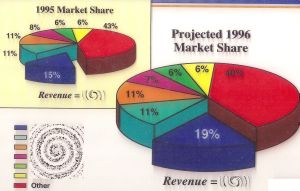Sales Guide Contents
Little more than an internal contact directory, the standard of corporate sales intranets has never been high. I know this because I spent a decade in this very space and still today take a keen glance at what’s on offer behind closed doors.
Without wishing to dwell on the whys and wherefores here, marketing-led initiatives fail because they do not align with how a salesperson must work to win, and plans that rely on the salesforce to wiki up their combined knowledge collapse for all sorts of other reasons. Chillingly, in my extensive experience here, less than half of big team b2b salespeople truly care about furthering their lot the 2.0 way.
Anyway, clearing out an old box of files I came across one large company’s Sales Guide from 1996. It was an enormous lever arch folder, almost six inches thick. The first item to greet you were the eight colour acetates of their core corporate presentation. Here’s a redacted version of the one supposed to precede your own territory additions.

The format was roughly; coverslide with snappy straplines, company background, key themes, bar graphs of volume/revenue/profits/eps growth, latest results, market share (above).
Everyone thinks they need a corporate presentation yet I feel virtually no-one uses their opportunity and messages correctly.
The next surprise was an old school cassette. Someone at HQ taped themselves talking turkey. All I’ll say here is I love this idea, yet the last time I used the same principle unbelievably only ten percent of the reps listened to their mp3.
As for the table of contents, I’ll summarise the main sections.
- Corporate Overview
- Market Overview
- Product Overview
- Sales Organisation
- Marketing Organisation
- Training & Support
- Admin
- Product Specs
- Competition
- Customer Directory
- Metrics
Try, if you can, to gloss over the fact that the marketing department took most pages to talk through. Product overview and specs differ in that the former pulls out the uniques and benefits, whereas the specs are almost technical bullets.
Is this a template that has stood the test of time? Well, so few companies attempt such a task direct comparison would be tricky.
Here’s the rub. If your typical salesperson always prefers to send a global email round in response to an immediate prospecting dilemma rather than proactively arm themselves with such defences, it doesn’t matter what you put in your folder, or nowadays online.
The shameful truth is that the numbers of salespeople that seek out best-practices and key messages from their colleagues, even when put on a plate for them, are the minority.
